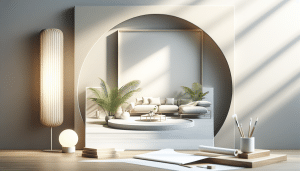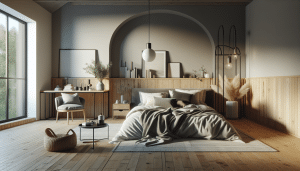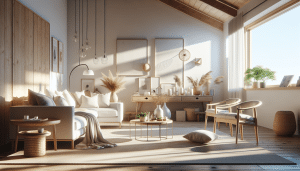Hidden Ways You Can Make Your Home Feel Like a Retreat
Samantha Lee September 24, 2025
Explore simple, impactful tips for transforming your living space into a sanctuary of calm and creativity. This guide unlocks expert-backed lifestyle strategies to help anyone design a home environment that promotes both relaxation and joyful, entertaining moments.
Creating Tranquil Spaces in Your Home
Designing your home as a peaceful retreat begins with understanding the connection between environment and well-being. Small changes, such as adding soft lighting, can transform the mood of a room instantly. Consider layering gentle lights with natural sunlight during the day and warm bulbs in the evening to soothe the senses. Many people find that the addition of houseplants brings both beauty and fresh air—a proven way to create a calm, welcoming vibe. Thoughtful arrangements of cushions, throws, and art can make a space feel tailored and serene, encouraging relaxation no matter the day’s stress.
The layout and flow of furniture have a significant impact on the energy within your home. Decluttering is one of the most accessible strategies to foster a peaceful atmosphere. Start with visible surfaces, organizing shelves, and removing items that no longer serve a purpose. Embrace minimalist decor to make rooms appear larger and more harmonious, as this approach is supported by environmental psychology experts. Implementing small organizing rituals, like returning items to their place after use, contributes to long-term tranquility and ease.
Adding sensory elements enhances a tranquil setting further. Aromatherapy diffusers with lavender or eucalyptus, the gentle gurgle of a tabletop fountain, and tactile accents like textured rugs all invite relaxation. Professionals recommend integrating music into your daily routines, playing soft instrumental or nature-inspired soundscapes. These subtle additions turn ordinary living quarters into nurturing sanctuaries, making home life uniquely satisfying.
Incorporating Personal Touches for Daily Joy
Personalization is the secret to a truly comforting home. Incorporate pieces that tell your story, spark joy, or carry positive memories. Photographs, souvenirs, or heirlooms offer instant warmth and connection, setting your living area apart from others. According to home design research, displaying meaningful items supports psychological well-being by fostering feelings of belonging and contentment. Whether bold artwork or a quirky lamp, let your own tastes shine through.
Engagement with creativity adds vibrancy and inspiration to every corner. Try rotating decor or seasonal accents to keep the environment fresh. Simple swaps—like bright pillows during the spring or cozy candles in winter—help the space evolve and delight the senses all year. Many people start with small DIY projects or handcrafts, finding joy in making unique improvements. This mindful approach to decorating builds a sense of accomplishment and personal satisfaction.
Color also plays a key role in self-expression. Choose hues that mirror your personality or moods—soft blues and greens for calm, vibrant reds or yellows for cheer. Experts in color psychology recommend considering both wall paints and accessories to subtly shift the emotional temperature of a room. This blend of personalization and creativity uplifts daily routines and adds excitement to ordinary moments at home, making each day feel special.
Maximizing Small Spaces for Comfort and Style
Even tiny apartments or rooms can become retreats with smart design choices. Opt for multi-functional furniture such as ottomans with storage, drop-leaf tables, or wall-mounted shelves to save space and reduce clutter. Professional interior designers often suggest vertical storage solutions, making use of unused wall areas for books or art. Clever placement of mirrors reflects light and creates the illusion of more space, brightening compact rooms and elevating comfort levels considerably.
Optical tricks can be a powerful ally. Use light, neutral color schemes on major surfaces like walls, curtains, and bedding to visually open up a room. Layering a few bold accent items on top offers personality without overwhelming the senses. Slide furniture away from walkways and cluster seating for better flow. Adding greenery—even just one lush plant—creates the impression of an indoor oasis regardless of actual square footage. Practical strategies like these have been endorsed by lifestyle experts as accessible to most dwellings.
Organization should always follow function. Group daily-use items where they’ll be needed and keep infrequently used objects tucked out of sight. This approach streamlines cleaning and keeps stress low, especially in homes shared by several people. Deliberate organization not only maximizes comfort but also ensures that even the smallest homes feel orderly and inviting—qualities that encourage both relaxation and spontaneous fun with guests.
Elevating Home Entertainment for Memorable Gatherings
Transforming a living room or outdoor patio into an inviting entertainment zone enhances everyday enjoyment. Flexible furniture arrangements make it easy to adapt the space for movie nights, board games, or dinner parties. Try modular seating options, stackable stools, or portable mini bars to quickly switch from intimate family evenings to lively social gatherings. Lighting once again plays a vital role: adjustable lamps or string lights create the right ambiance for any occasion without much fuss.
Sound quality matters in entertainment spaces. Investing in a compact sound system or strategically arranging speakers can immerse everyone in music or movies. If outdoor gatherings are popular, consider weather-resistant speakers or simple picnic-style setups for alfresco enjoyment. This allows every get-together to feel well-considered and memorable, regardless of budget. Experts often point out that background music can set a mood and elevate the overall atmosphere of a gathering (Source: https://www.npr.org/2021/06/13/1005017223/how-music-affects-the-brain).
Personal touches make events stand out further. Themed snacks, signature drinks, or a rotating set of board games personalize every event. Rotate artwork or digital slideshows on smart TVs for added interest. Hosting regularly cultivates deeper friendships and sharpens hospitality skills, while keeping household routines lively and rewarding. With creative planning and attention to detail, even impromptu gatherings can feel special—turning any night at home into a celebration of lifestyle and entertainment.
Infusing Wellness Practices Into Home Life
Wellness has become a cornerstone of modern lifestyle and home décor. Creating a dedicated nook for mindfulness practice, meditation, or yoga brings long-reaching benefits to mind and body. Many people transform an unused corner with a simple mat, a few cushions, and calming accents like candles or essential oil diffusers. The home then supports daily routines that boost relaxation, clarity, and focus—a true investment in overall well-being (Source: https://www.health.harvard.edu/mind-and-mood/mindfulness-meditation-improves-well-being).
Daily movement can also be enhanced with minimal equipment. Resistance bands, compact weights, or foldable exercise machines fit into closets or under beds when not in use. The goal is to gently encourage movement throughout the day, such as light stretching or dance breaks, instead of waiting for motivation to visit the gym. By making wellness routines visible, it becomes easier to integrate healthy choices naturally into home life, benefiting physical and emotional health alike.
Air quality and natural light are often overlooked aspects of wellness. Invest in indoor plants, air purifiers, or even regular window cleaning to maximize fresh air indoors. Arrange furniture to capture sunlight, boosting mood and supporting natural circadian rhythms. Studies repeatedly confirm that light and air have tangible effects on wellness. Over time, these small adjustments form the foundation of a content, energetic, and resilient home life (Source: https://www.epa.gov/indoor-air-quality-iaq/indoor-air-quality-home).
Eco-Friendly and Affordable Upgrades for Modern Living
Prioritizing sustainability in home décor and lifestyle choices doesn’t require major renovations. Swapping single-use items for reusable alternatives, like cloth napkins or stainless steel straws, helps lower environmental impact. Upcycled décor—such as repurposed furniture or thrifted art—reflects creativity and supports conscious consumption. Even simple changes, like energy-efficient LED bulbs or programmable thermostats, reduce household costs over time, making eco-friendly living accessible and budget-friendly (Source: https://www.energy.gov/energysaver/energy-saver).
Exploring local resources, such as farmer’s markets or community swap groups, empowers people to build more sustainable lifestyles. Many communities host repair cafés and tool libraries, encouraging neighbors to fix or borrow rather than buy new. These opportunities foster a spirit of cooperation and keep budgets in check, all while reducing waste and supporting local economies. Experts suggest that the cumulative impact of these choices can be significant, especially when adopted widely over time.
Water conservation and gardening are additional ways to green your living space. Indoor herbs and edible plants on balconies can supplement meals and connect people with nature. Low-flow faucets and rain barrels reduce consumption and support ecological responsibility. With growing awareness and access to practical resources, anyone can start building an eco-friendly home in small, satisfying steps—contributing to global sustainability while enjoying a stylish, functional living environment.
References
1. Harvard Health Publishing. (n.d.). Mindfulness meditation improves well-being. Retrieved from https://www.health.harvard.edu/mind-and-mood/mindfulness-meditation-improves-well-being
2. U.S. Environmental Protection Agency. (n.d.). Indoor air quality in your home. Retrieved from https://www.epa.gov/indoor-air-quality-iaq/indoor-air-quality-home
3. U.S. Department of Energy. (n.d.). Energy saver guide: Tips on saving money and energy at home. Retrieved from https://www.energy.gov/energysaver/energy-saver
4. National Institutes of Health. (n.d.). Plants in the home: Health benefits. Retrieved from https://nccih.nih.gov/health/providers/digest/herbs-at-home.htm
5. NPR. (2021). How music affects the brain. Retrieved from https://www.npr.org/2021/06/13/1005017223/how-music-affects-the-brain
6. American Psychological Association. (n.d.). Declutter your mind by decluttering your space. Retrieved from https://www.apa.org/monitor/2019/02/clutter







